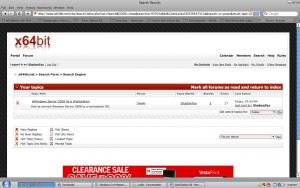I present to you, one of the most solid server editions and ease of use editions to a workstation, I consider it as a thought with me in mind
You may use this walkthrough to convert your Windows Server 2008 to what I call Windows Workstation 2008
Firstly WHY? might you ask. To put it simply, Microsoft has a bad habit of putting in all this bloated software that hogs memory and really brings down the performance of your PC. With past experiments with XP and Server 2003 we noticed an improved performance increase with using a server platform as a base. The reason being that even when you strip down XP you still have bloated software running in the background, besides, it's a lot of fun to do
----- CONVERTING YOUR WINDOWS SERVER 2008 TO A WINDOWS WORKSTATION 2008 WALK THROUGH -----
Registration Information
To change your computers registered owner and organization name click Run in the Start menu, enter regedit and click OK. In the Registry Editor navigate to HKEY_LOCAL_MACHINE -> SOFTWARE -> Microsoft -> Windows NT -> CurrentVersion. In the right pane doubleclick and edit RegisteredOwner to change your registered owner and/or doubleclick RegisteredOrganization to change the registered organization. Minimize the screen as we will need the Registry editor later on.
Now if you open the Windows About window by clicking Start , Run, type in winver and click OK, you can see that the owner settings have been changed.
Adding Users, Settings Shutdown Permissions, and Turning on Shut Down Sounds
In the Start menu click Run and type control userpasswords2. In the User Accounts window that comes up click Add, fill in the required fields and click Next.
Fill in a password twice and click Next. In the next screen select Standard User to create a limited account to work with, then click Finish to add the user.
If you selected Standard User as level of access, you have to give the user permission to shutdown the PC. To do this click Run in the Start menu, then type gpedit.msc and click OK. In the Local Group Policy Editor that opens, browse to: Computer Configuration -> Windows Settings -> Security Settings -> Local Policies -> User Rights Assignment. In the right pane scroll to Shut down the system .
Double click Shut down the system and click Add User or Group. Now enter the User name of the user you want to give permission to shut down, and then click OK.
Finally click OK in the Shut down the system Properties window to save the changes you made to the list of users that are allowed to shutdown the computer. While where here let’s turn off that pesky Shut Down Tracker.
While still in the gpedit.msc window, Browse to Administrative Templates in Computer Configuration, click System and double click in the right window on Display Shutdown Event Tracker. Change its value to Disabled and click OK to save the change. Since you’re in the gpedit.msc window still, let’s enable Startup Sounds. Browse to the Local Computer Policy -> Computer Configuration -> Administrative Templates -> System -> Logon, and open the Setting Turn off Windows Startup Sound. In the Turn Off Windows Startup Sound Properties window click Disabled, then save the setting by clicking OK.
Turn off the Ctrl+alt+del at Start up
In the Start menu, expand Administrative Tools and click Local Security Policy.
In the Local Security Policy editor expand Local Policies and click Security Options. In the right pane search and open Interactive logon: Do not require CTRL+ALT+DEL and choose Enabled. Save your change by clicking OK.
Audio
Click Run in the Start, then type services.msc and click OK. Now the Services Management Console will open.
In the Services window scroll to the service Windows Audio and open it. In the Windows Audio Properties (Local Computer) window select Automatic as Startup type, click Apply, then click Start to start the Windows Audio service. Close the properties window by clicking OK. Since you have the Services window open, navigate down to Themes, set Startup type to Automatic and click Apply. Clicking Start will not start the themes service as we haven’t installed any, I have saved it for last because it requires a reboot. Close the service manager.
Performance
To fully convert the Windows Server 2008 into a workstation we have setup that programs will have the best performance instead of background services.
To change to the best performance setting into programs, open Start, right click on Computer and select Properties in the context menu.
On the left below Tasks click Advanced system settings. In the Performance section click Settings. After that the window Performance Options shows up. Go to the Advanced tab, select Programs and click OK twice to save these settings.
Disable Internet Explorer ESC
Start the Server Manager by clicking the Server Manager icon in the systray, or the Server Manager shortcut in directly the Start menu or in the Administrative Tools menu.
Scroll down to Security Information within Server Summary and click Configure IE ESC. In the window that pops up select Off for both Administrators and Users. Save the changes by clicking OK.
SuperFetch
To enable the SuperFetch service you will first have to make a little change in the registry. Open the Registry Editor. In the Registry Editor browse to the location HKEY_LOCAL_MACHINE\SYSTEM\CurrentControlSet\Control\Session Manager\Memory Management\PrefetchParameters.
Right click in the right part of the window and under New choose DWORD (32bit) Value. Type in: EnablePrefetcher
Edit the value of value EnablePrefetcher by double clicking on it. Change the Value data field into ‘3‘ (without quotes).
Next create a second DWORD (32bit) Value, name it EnableSuperfetch and also give it as Value data ‘3‘ (without quotes)
Close the Registry Editor, and then click Run in the Start menu. Type services.msc and click OK. In the Services window, scroll down to the service with name SuperFetch.
Right click on the SuperFetch service and choose Properties in the context menu.
Next choose in the Startup type dropdown Automatic. Click Apply in the lower right of the Superfetch Properties window. Press the Start button to enable SuperFetch for your current session, because we have set the Startup type to Automatic, next time you start Windows Server 2008, the SuperFetch service will run to optimize your systems performance.
Wireless, .NET 3.0, Themes, Networking and Video
Start the Server Manager by clicking the Server Manager icon in the systray, or the Server Manager shortcut in directly the Start menu or in the menu Administrative Tools.
In the Server Manager scroll down to Features Summary and click Add Features. In the Add Features Wizard window scroll down, check.NET Framework 3.0 Features, Desktop Experience, Windows PowerShell, and Wireless LAN Service, if a pop-up prompts you telling you that IIS and such needs to be installed as well, just click ok and it will select them for you, now click Next.
At the Confirm Installation Selections page click Install.
Click Close to finish the installation, and Reboot. Welcome to Windows Workstation 2008!
Mouse Pointers
Download aero_cursors.zip
 aero_cursors.zip 147.3K
637 downloads.
aero_cursors.zip 147.3K
637 downloads.Open aero_cursors.zip and browse within the archive to the folder cursors. Within the cursors folder select all files by pressing CTRL+A, and copy them by pressing CTRL+C.
Browse with Windows Explorer to C:\Windows\Cursors and paste press CTRL+V. All Aero cursors will now be unpacked to your system.
Go to the root of the aero_cursors.zip archive and double click at the aero_cursors(.reg) file. Click Yes when the Registry Import warning appears.
In the Start menu click Control Panel.
- If you use the Modern View, click Mouse in the Hardware and Sound section.
- If you use the Classic View, double click the Mouse icon.
In the Mouse Properties window click tab Pointers, select Windows Aero from the Scheme dropdown list. Optionally you can also check the Enable pointer shadow, Close the Mouse Properties Window.
Themes (part 2)
Right click on an empty spot of your desktop and choose Personalize. In the Personalization window click Theme. Select the Browse… option from the dropdown if the theme Windows Vista is not already listed.
If theme Windows Vista was not listed, browse to the folder C:\Windows\Resources\Themes, then select aero and click Open. Apply your selection by clicking OK.
If you have installed drivers for your video card you can also enable transparent window borders and 3D Flip (Windowskey + Tab) with Windows Aero Theme instead of the Windows Vista Basic theme. To do this click Window Color and Appearance in your Personalization window, select Windows Aero and click OK.
Now you have the Security of Windows Vista, and the Reliability of a Server. Enjoy your Workstation 2008




















